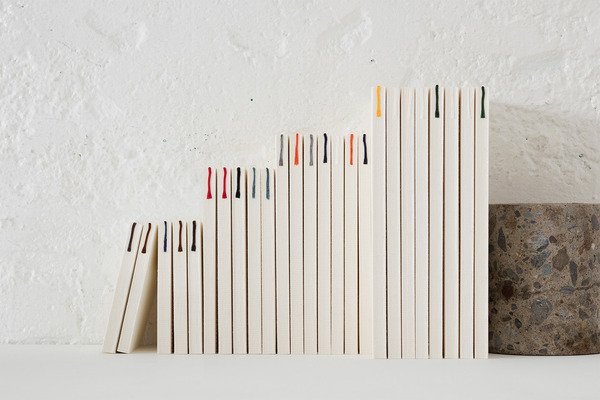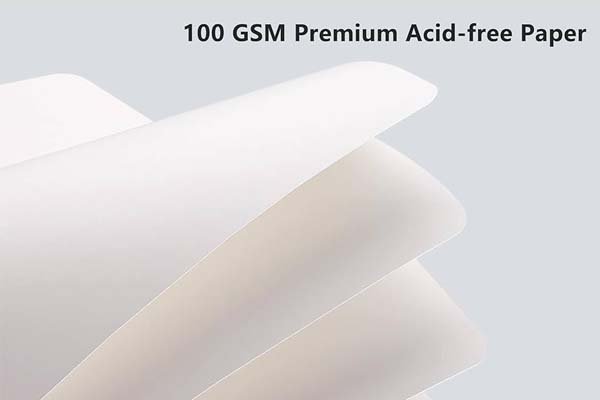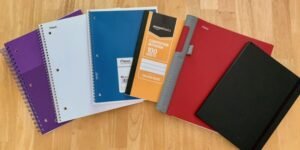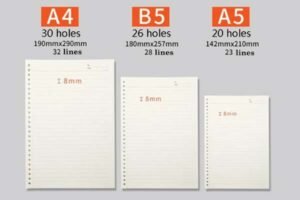
Struggling to balance notebook thickness with paper quality? A mismatch can lead to a product that's too bulky or feels cheap. We will explain how these three elements connect.
Page count, paper quality1, and thickness are directly related. More pages or heavier paper (higher GSM2) will always create a thicker notebook. This core relationship impacts the final feel, portability, binding style, and cost of your custom notebook.
This connection is simple but crucial. Understanding it helps you make better decisions for your product. For example, a travel journal needs to be slim and portable. This means you might choose fewer pages or a lighter paper. But a high-end corporate gift needs a premium feel. So, you might select a thick, high-GSM paper, even if it means fewer pages or a stronger binding. As a manufacturer since 2006, we guide our clients through these choices every day.
We help you balance these three factors to meet your specific goals. You might want a notebook for an educational institution, a corporate gift, or a designer brand. Each has different needs. A student notebook might prioritize a high page count3 for notes. A business notebook might focus on premium paper quality for a better writing experience. We help find the perfect balance for your project and budget.
How does paper weight (GSM) relate to page count?
Wondering how paper weight influences the number of pages you can have? The two are closely tied. It's a balance between feel and function.
Paper weight, measured in grams per square meter (GSM), determines the thickness and stiffness of each sheet. For a fixed notebook thickness, a higher GSM paper means you can include fewer pages. A lower GSM paper allows for more pages.

Understanding GSM and Its Impact
GSM is the standard measure for paper density. It’s not just about thickness; it also affects the paper's opacity (how much ink shows through) and durability. At NotebookRing®, we offer a range of paper options to suit different needs.
- 80gsm Paper: This is a standard, versatile weight. It's great for everyday notebooks, providing a good balance between page count and a quality feel. It’s cost-effective for bulk orders, like for educational institutions.
- 100gsm Paper: This paper is thicker and more premium. It feels more substantial and reduces ink bleed-through. It is a popular choice for corporate gifts. Upgrading from 80gsm to 100gsm costs an additional $0.07 per book.
- 120gsm Paper: This is a heavy, luxurious paper. It's ideal for sketchbooks or high-end journals where quality is the top priority. It's suitable for artists who use different media.
Practical Scenarios
Let's think about our typical customers.
- For Sarah in Germany: She needs campus notebooks for students. A high page count is essential for a full semester of notes. We would recommend 80gsm paper. This allows for more pages without making the notebook too heavy or expensive for students.
- For James in Singapore: He creates corporate gifts. The impression of quality is key. We would suggest 100gsm or 120gsm paper. Even with fewer pages, the substantial feel of the paper communicates a premium value.
Here’s a simple table to show the relationship.
| Paper Weight (GSM) | Typical Use Case | Feel & Opacity | Page Count Potential (in a 1cm thick book) |
|---|---|---|---|
| 80gsm | Student notebooks, drafts | Standard, moderate opacity | ~200 pages |
| 100gsm | Business journals, planners | Premium, good opacity | ~160 pages |
| 120gsm | Art sketchbooks, luxury gifts | Very thick, high opacity | ~130 pages |
Does more pages mean thinner paper?
You want a notebook with lots of pages, but you don't want it to be a heavy brick. So, does that mean you have to use thinner paper?
Not necessarily. You can have a high page count with thick paper. However, this will result in a very thick notebook. If you need a high page count but also a slim profile, choosing a thinner, lower GSM paper is required.
The Thickness Equation
The final thickness of a notebook is a simple calculation: (Page Count / 2) x Paper Thickness + Cover Thickness. You have three main variables to work with: page count, paper thickness (GSM), and the binding method, which must accommodate the total bulk.
Let’s look at a real-world example. One of our clients, a Japanese stationery brand managed by Yuki Nakamura, had a specific challenge.
Case Study: Yuki Nakamura's Ultra-Thin Planner
Yuki wanted to develop an ultra-thin weekly planner. The goal was a final thickness of 8mm or less, but it needed to contain over 200 pages for a full year of planning.
- The Problem: A standard 80gsm paper would make a 200-page notebook too thick. A standard glue binding would also struggle to hold that many pages together tightly in a thin format.
- Our Solution: We sourced a special, high-quality 70gsm paper. This paper is thin but still durable and opaque enough to prevent heavy ink bleed. We then used a specialized glue binding technique that can securely hold over 200 pages while allowing the book to lay flat.
- The Result: We successfully produced a sleek, portable planner that met the strict ≤8mm thickness requirement. It became a top seller for their brand.
This shows that you don't have to sacrifice page count for a slim design. But you must be strategic about your material choices.
Is page count linked to printing costs?
When budgeting for a custom notebook order, you need to know what drives the price. Does adding more pages significantly increase your costs?
Yes, page count is a primary factor in the final cost. More pages mean more raw material (paper) and more machine time for printing and binding. This directly increases the per-unit cost of a notebook.
Breaking Down the Costs
The cost of a notebook isn't just one number. It's made up of several components. Understanding these helps you see where your money goes.
Primary Cost Drivers
- Paper Consumption: This is the most direct cost. A 200-page notebook uses twice as much paper as a 100-page notebook.
- Printing Time: Each page needs to be printed. More pages mean longer runs on our Heidelberg presses.
- Binding Process: Some binding methods are more labor-intensive or require more materials for thicker books.
How We Manage Costs for You
We help you manage these costs effectively. Our long-term focus on stationery manufacturing gives us efficiencies that we pass on to you.
| Order Quantity | Price Range (Standard Notebook) | Key Benefit |
|---|---|---|
| 1,000+ notebooks | $0.84 - $1.70 USD | Accessible for smaller projects |
| 10,000+ notebooks | $0.63 - $1.30 USD | Significant per-unit cost savings |
For one of our clients, a Silicon Valley tech company, cost reduction was a major goal. They needed an employee onboarding gift box. We designed a set with a metal binder and custom weekly plan inner pages. By optimizing the page count and using our efficient production lines, we helped them reduce their procurement costs by 32% compared to their previous supplier.
Does page count affect binding method?
You’ve decided on your paper and page count. Now, how do you hold it all together? The number of pages directly influences which binding methods are possible.
Absolutely. A low page count notebook can use almost any binding. But a very thick notebook with 300+ pages has fewer options. The binding must be strong enough to hold the pages securely and allow the notebook to function well.
Matching Binding to Bulk
Choosing the right binding is about durability and usability. A binding that is too weak will fall apart. A binding that is too rigid will prevent a thick notebook from laying flat.
Let's look at the options we provide at NotebookRing®.
Common Binding Methods and Their Page Count Suitability
1. Sewing Glue Binding
This method is strong and allows the notebook to lay relatively flat. It's excellent for premium journals and corporate notebooks.
- Best for: 80 to 240 pages.
- Limitation: It becomes difficult to achieve a true 180° flat-lay with very high page counts (over 250 pages).
2. Metal Coil (Spiral or Wire-O)
This binding allows a notebook to fold back on itself and lay perfectly flat. It's a versatile choice for planners and manuals. Our patented "seamless coil" technology provides a smooth 360° touch without snagging.
- Best for: 20 to 300 pages.
- Limitation: Coils can get bent with rough use, and the look might not be suitable for all luxury brands.
3. Binder System (Ring Mechanism)
This offers the ultimate flexibility. The page count is limited only by the ring size. It's ideal for refillable planners and customizable systems.
- Best for: 1 to 400+ pages.
- Advantage: We can produce inserts compatible with international standards like Filofax and Campus.
A German chain bookstore came to us for a series of plant atlas notebooks. They needed the books to lay perfectly flat to display the detailed illustrations. The page count was around 150 pages. We used a special bare-spine sewing method. This achieved a perfect 180° flat design, which was critical for their product's success.
Choosing the right paper and pages for buyer needs
How do you put all this information together? The best choice always comes back to one thing: the specific needs of your end-user and your brand.
To choose correctly, first define the notebook's main purpose (e.g., daily notes, executive gift, artistic sketching). Then, balance page count, paper quality (GSM), and thickness to match that purpose while staying within your budget.
A Practical Decision Framework
Think about your goals from three perspectives: Function, Feel, and Finance.
1. Focus on Function
- Who is the user? A student, a corporate executive, an artist?
- What is the use case? Quick notes, long-form journaling, sketching, project planning?
- Example: For Sarah Müller's student notebooks, the function is paramount. Students need a high page count to last a semester and durable binding. An 80gsm paper with a strong spiral or sewn binding is a practical and functional choice.
2. Focus on Feel
- What is your brand identity? Eco-conscious, luxurious, minimalist?
- What impression should the product make? A premium gift, a practical tool?
- Example: For James Wong's corporate gifts, the feel is everything. A 100gsm or 120gsm paper provides a sense of quality. A refined hot stamping or laser engraving of the company logo on the cover completes the premium experience. The page count can be lower because the primary value is in the quality, not the quantity.
3. Focus on Finance
- What is your budget per unit?
- What is your total order quantity?
- Where can you be flexible? Can you reduce page count to afford better paper? Can you choose a more cost-effective binding?
- Example: We offer flexible customization, even for smaller orders. For a startup brand with a limited budget, we might suggest starting with a 500-unit batch production. We could use a standard 80gsm paper but add a unique touch with an embossed cover, providing a custom feel without a high cost.
By asking these questions, you can navigate the relationship between page count, paper quality, and thickness to create the perfect notebook for your market.
Conclusion
Ultimately, the perfect notebook balances page count, paper quality, and thickness to meet your specific needs. Understanding how these elements work together allows you to create a functional, high-quality, and cost-effective product. We are here to help you find that perfect balance.
-
Understanding paper quality is essential for creating notebooks that meet specific needs and enhance user experience. Explore this link to learn more. ↩
-
GSM is key to understanding paper thickness and quality. Learn how it impacts your notebook choices and overall product feel. ↩
-
Page count is a crucial factor in notebook design and pricing. Discover insights on how to balance it effectively for your projects. ↩





